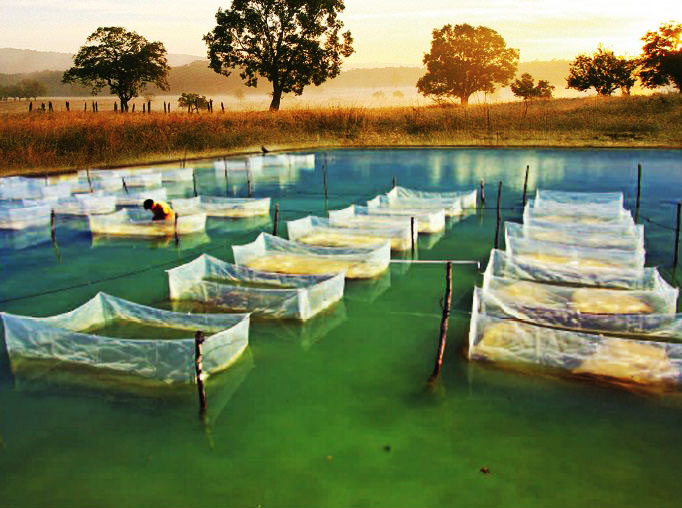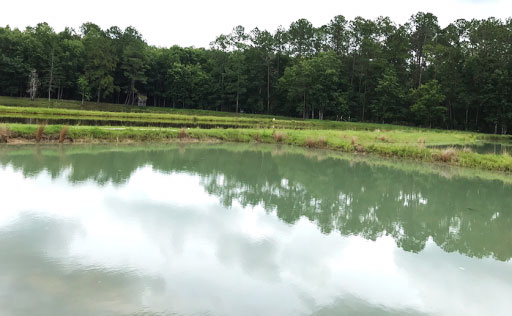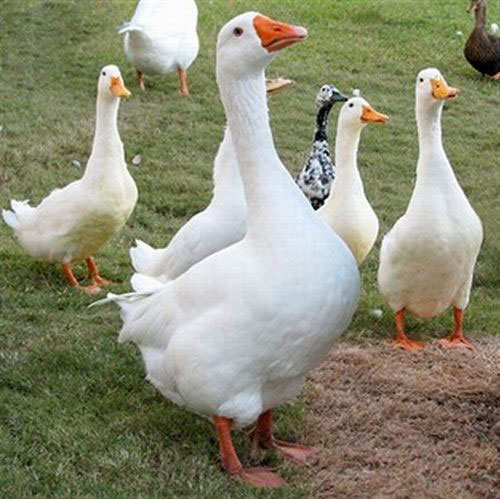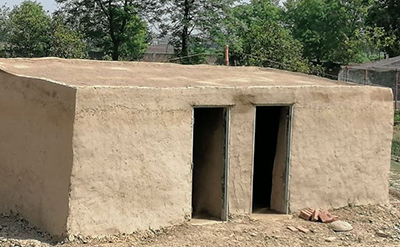Fish Ponds & Duck Farming
Fish Ponds:
Raising fish commercially in tanks or enclosures such as fish ponds, usually for food. A facility that releases juvenile fish into the wild for recreational fishing or to supplement a species’ natural numbers is generally referred to as a fish hatchery.
Types of Fish Ponds:
Several kinds of ponds are required for fish culture, depending upon the function performed by each.
Rearing Pond – These are larger ponds, usually of 30 x 10 x 1.25 m, and are used for rearing advanced fry till they grow into fingerlings. They may be seasonal or perennial and have a gentle slope to facilitate netting of fingerlings.
Hatching Pits – These are small tanks that are used for hatching of fertilized eggs, and are provided with continuous slow flowing water for aeration.

Spawning Pond – This is a small pond in which brood fish are placed for spawning. Brood fish may also be placed in hapas for spawning.
Nursery Pond – These are larger ponds for newly hatched fry. Usually it is 15 x 15 x 1.2 m and is seasonal which dries up during summer.
Stocking Pond – This is a large perennial pond, more than 2 m deep and is used for the growth of fish to marketable size. The size of the pond depends upon the fish species to be cultured.

Construction of a Fish Pond:
Before constructing a fish farm, selection of a suitable site is important. Economy of construction and productivity of the ponds depends largely on its location. The main consideration should be the topography, soil type and source of water. A gently sloping terrain of a valley, or a bowl shaped area with high lands on three sides and a narrow outlet on the fourth, are considered to be ideal for a fish farm, provided the soil is suitable and water supply is available.
Such an area can be easily converted into a large pond by constructing an embankment on one side to close the outlet. The soil must be impervious to the water. Rocky and sandy soils should be avoided and silty clay is preferred. If the land has been used for agriculture, soil should be tested for residual pesticides, which are toxic to fish.
Soil should be tested by a soil analyst to determine whether or not the soil is capable of holding water, especially during the dry season. Nursery and rearing ponds can be constructed on porous soil, as they are seasonal and are required to hold water for a short period; but for stocking ponds, porous soil should be treated with clay or suitable soil-sealant is spread over the bottom in several layers to make it impervious.
Availability of adequate supply of water is an important consideration. Rivers, lakes or big reservoirs are considered to be the best source of water. Streams, canals and wells are also good and dependable source of water for the ponds. Arrangement should be made for proper drainage. Ponds should be so constructed that each can be drained completely and individually, and water can be replaced with fresh oxygenated water.
The drain pipe of the pond should be large enough for quick drainage. The inlet pipe should be 15-20 cm above the water level, and must be provided with a screen to prevent the entry of wild fish. A screen should be placed at the end of the outlet also to check loss of fish. Another factor to be considered is that the pond should be free from overflow or flooding from rain water.
Layout of a Fish Pond:
The layout of a fish farm depends upon the total area available, species to be cultured, and the type of farming to be practised. For restricted farming, fry and fingerlings are procured from the market, and are grown in ponds to marketable size. For this few rearing and stocking ponds are required to be constructed.
But in complete fish farming a larger number of tanks are required for specific purpose, as the brood fish are spawned, eggs are hatched, fry are reared to fingerlings and adults. Before constructing the ponds, selected site is cleared of all the trees, stumps, rocks and stones, which are likely to interfere with netting and harvesting operations.

Ponds should be arranged in such a way as to provide maximum efficiency of production. Usually small farms (1-5 acre) are preferred as they are easy to manage, and small ponds can be drained and refilled quickly, facilitating better care of the fish.
Ponds can be arranged in one of the following ways:
- Ponds are constructed in a series, one behind the other, and are connected to each other. Water from the source is supplied to the ponds by a channel, and the last pond has an outlet to drain excess of water. Ponds are connected to each other and one overflows into the other.
- Ponds are arranged parallel to each other and have separate inlet and outlet so that water from one pond does not overflow into the other. They may be built in one or two rows. A screen is always provided near the inlet and outlet to prevent entry of wild fish, and loss of culture fish.

Duck Farming
Ducks can be raised with success and at a profit on general farms, but are not so well adapted as fowls to supply a source of income under average farm conditions, although they serve to add variety of both meat and eggs for the farmer’s table. Breeds of ducks which are of good, marketable, table quality and also are fair egg producers, are best suited for use on general farms and may be kept profitably wherever good pasture land with running water is available. Their house should be near the water, and the site should be fenced sufficiently to keep livestock away. Farmers rarely give the necessary care to their ducklings in either feeding or marketing to be able to cater to the trade in fancy green ducks.
The pens in the houses, the outside yards, and the arrangement of the buildings should be planned so that the ducks may be easily driven from house to house. The feed room or house should be centrally located.
Houses
The site of the poultry houses should be dry, well drained, and higher than the general level of the land. A light, porous soil is best. A shed-roof breeding house, 18 feet deep, 32 feet long, 8 feet high in front, and 5 feet in the rear, provides desirable quarters and will hold from 100 to 125 breeders. It is desirable to allow from 4 to 6 square feet of floor space for each breeding duck (fig. 10). Breeders are kept in flocks of from 75 to 250, although from 100 to 150 is the usual number. The number and size of the openings and the ventilation in the laying house should be adapted to the climate. The houses illustrated are on Long Island. About one-third of the front consists of glass windows and of space for muslin curtains, in equal proportions.

A glass window in the east end and one in the west end help to ventilate and dry out the house on mild days. Ventilation is of vital importance, as the comfort and health of the ducks depend on an abundant supply of pure, dry air. A dirt floor from 4 to 6 inches above the ground level is satisfactory on light, well-drained soil. Board floors may be used if raised 6 to 8 inches above the ground and covered with 4 inches of sand or dry earth.
The breeding pens should be bedded with additional straw or shavings whenever the litter gets wet and soiled the litter may be allowed to accumulate in cold weather as it helps to keep the ducks comfortable. This practice, however, makes good ventilation absolutely necessary. During the day, except in stormy and cold weather, all windows should be opened wide to allow the bedding to dry. Nests are usually provided. They are made like stalls, 12 inches wide and 18 inches deep, separated with boards about 12 inches high. The partition boards are nailed to a strip about 5 inches high, which forms the front of a row of nests placed against the back or side of a building. Some breeders provide no nests, but allow the ducks to lay on the floor. The yards should be about 100 feet long and the width of the pen, and extend 30 feet into the stream if possible. Wire poultry netting about 2 feet high will keep mature ducks in their respective yards, and netting 18 inches high will hold ducklings.

Selecting & Matting:
The selection of large, vigorous breeding ducks that have broad, deep bodies, is essential to success in duck farming. The breeding stock is usually selected from the market ducks when they are from 8 to 10 weeks old. The drakes are selected during June and the females during the early part of July. Only the most vigorous and best-developed ducks are saved for breeding (fig. 13). These ducks are kept only during their first laying season and are then marketed. Older ducks do not lay eggs enough during the early part of the winter to produce sufficient numbers of market ducks, but a few of the best birds are sometimes kept for breeding stock.
Fish Farming – A Lucrative Business – External Link
Fish Farming: A Profitable Venture – External Link
Make your fish farm more environmentally sustainable – External Link
Duck Farming Business Plan For Beginners – External Link
Duck farming – Duck welfare – Free range farming – External Link
Duck Farming – External Link




